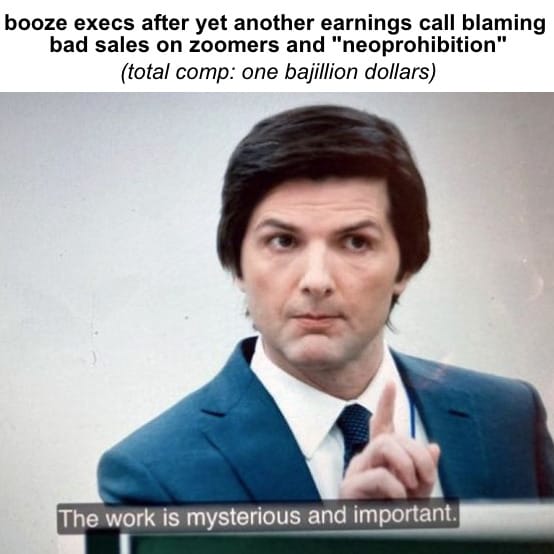- Fingers
- Posts
- Booze CEOs "earned" so much more than their workers last year
Booze CEOs "earned" so much more than their workers last year
Plus: Betting on Kyrsten’s Krug!

Like so many consumer-package-goods (CPG) industries, selling drinks is a business of scale. Breweries are expensive physical plants; wine and spirits are heavy liquids that cost a lot of money to ship; advertising costs more money still. The bigger the firm, the better positioned it is to achieve those sweet, sweet economies of scale, defend thin margins, and make fortunes on volume. Craft brewing, micro-distilling, and small-bore winemaking exist in spite of this reality, which is why very few people get rich on the “long tail” of the beverage-alcohol industry. But on the other end of the spectrum, where cluster the United States’ biggest, makers and sellers of drinks, people are getting very rich—and they’re doing it on the backs of workers that they’re paying pretty poorly.
For example: chief executive officers. CEOs! You heard of these? The people at the top of the org chart that gripe about remote workforces, deliver carefully scripted speeches on earnings calls, and definitely couldn’t easily be replaced by the same artificial-intelligence software they’re currently obsessed with using to replace everyone else? You know the ones. They’re stacking cash. According to the American Federation of Labor and Congress of Industrial Organizations’ (AFL-CIO) just-released 2025 Executive Paywatch report, CEO pay at an S&P 500 company averaged just under $19 million last year in total compensation, with around $9 million. You could argue about whether they “earned” this enormous payout. But that’s a tedious distraction from the real story, which is that the median worker at these companies made just $49,500 last year. Like, for the whole year.
The yawning chasm between these two cohorts is called—you guessed it—the CEO-to-worker pay ratio, and after coming down a bit from pandemic-fueled highs earlier this decade, it’s growing again, with head honchos grabbing a 7% average raise last year compared to the 3% bump their workers received. For 2024, the AFL-CIO found an average ratio of 285-to-1, meaning for every $285 a US firm’s top exec makes, their lowliest worker makes just $1. Seems bad! And it is bad, for all sorts of social and political reasons I will not hammer on about here. But how does the drinks business stack up? Fingers combed through the labor organization’s data for S&P 500 and Russell 3000 firms in the beverage-alcohol industry, as well in broader CPG and food-service sectors to find out.
Reply